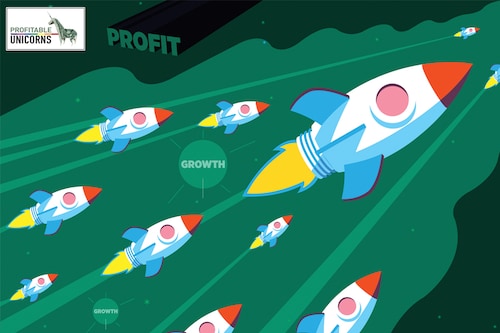India needs more profitable unicorns: Ashish Sharma
India's unicorn stable needs more startups that can strike a balance between growth and profitability, the managing partner at InnoVen Capital writes



Over the last decade or so, a narrative took hold that successful startups, particularly in the consumer space, must prioritise growth over anything else. After all, investors only back founders going after large market opportunities, rather than a niche profitable business.
Haven’t all great companies like Google, Microsoft, Amazon executed the same playbook– big idea, raise a lot of capital, innovate fast, hire the best talent, invest aggressively to acquire customers, and eventually annihilate the competition? Haven’t we all heard about the ‘Winner takes all’ model, where the flywheel of profits kicks in as the sector transitions to a monopoly (or duopoly)?
Nothing could be farther from the truth. Microsoft was profitable in its first year, PayPal in two years, Google turned a profit in its third year, Facebook in its fifth year, Netflix in six years and Airbnb/ Amazon in under nine years. Even Tesla, which as a category creator had to invest heavily, also turned its first profit in ten years.
Till a decade ago, startups raised a few rounds of private capital and then had to either access public markets or entertain buyout offers from a larger player. Since availability of private capital was limited, companies couldn’t sustain a ‘Growth at all costs’ playbook for long and had to take a more disciplined approach in balancing growth and profitability.
Availability of private capital (and lots of it) gave founders an option to continuously raise capital and stay private for a much longer time. The US venture capital investments increased 10-fold to over $300 billion in 2021. Mega funds like promising companies could now focus on growth and not worry about profits or quarterly analyst calls.
The vanity metrics that got rewarded were GMV, market share, user growth, DAU/MAU, and many founders and investors rationalised that profits will eventually follow. Some didn’t even care about profits as several high-profile, loss-making companies continued to raise money at ever-increasing valuations, while a few were also able to access public markets, thereby giving investors great exits.
Bill Hewlett, co-founder of Hewlett Packard (HP), once warned his team that “More companies die of indigestion than starvation" at a time when HP was growing fast with lots of capital. Raising way too much capital, even at significantly higher valuations, comes with an expectation that the company will continue to grow fast to justify returns for late-stage investors. History shows that only a few companies can achieve the growth
With so much liquidity at their disposal, many companies resort to investing heavily in brand building, performance marketing, over-hiring, customer discounts and glitzy marketing campaigns, without being thoughtful about returns.
Narratives of companies like Amazon have been quoted often to argue that once the company becomes the dominant player, profits will follow. This is often difficult, and one can look at the global ride-hailing industry, where all players have struggled to turn in a profit, despite raising tens of billions of dollars over a decade in a monopoly or duopoly industry structure.
Yes, it’s true that going after large addressable markets requires upfront investments but it’s also true that world-class companies can achieve profitability in a reasonable time. While ‘one size fits all’ cannot be applied to all sectors, founders and investors must take a nuanced approach considering the size of the prize (market), ability of the business to monetise, lifetime value of the customers, ability to cross-sell, customer’s ability to pay, competitive dynamics etc.
 GE’s legendary CEO Jack Welch once reminded his managers that “Control your own destiny or someone else will," and the same lesson holds true for founders.
GE’s legendary CEO Jack Welch once reminded his managers that “Control your own destiny or someone else will," and the same lesson holds true for founders.
Most founders start with a frugal mindset, but some change along the way, often due to unrealistic investor expectations or peer pressure. There is nothing wrong about raising a lot of capital at high valuations. It’s also acceptable that some early-stage investors, founders, and employees get nice returns before a company turns profitable. However, just optimising for the next capital raise and valuation, with no credible path to profitability, will lead to a situation where all it takes is one failed fundraise and you don’t control your own destiny.
The Indian venture ecosystem has grown impressively, and there is a lot to cheer about—the innovation, entrepreneurial spirit, and big ideas. With 100+ unicorns and a few public companies, where millions of retail investors have reposed their faith, it’s important that we see the emergence of more enduring and sustainable business models coming out of India. This will then ensure that entrepreneurs get supported by private capital, and all stakeholders (founders, employees, investors) generate healthy long-term returns, thereby keeping the flywheel in motion. I am optimistic that we will see some great entrepreneurs build world-class businesses out of India.
The author is managing partner at InnoVen Capital, India’s biggest venture debt fund
First Published: Sep 23, 2022, 14:40
Subscribe Now